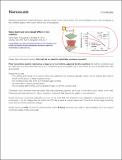| dc.contributor.author | Berggren, Karl K. | |
| dc.contributor.author | Yang, Yang | |
| dc.contributor.author | Short, Michael P | |
| dc.contributor.author | Kim, Chungsoo | |
| dc.contributor.author | Li, Ju | |
| dc.contributor.author | Li, Yong Gang | |
| dc.date.accessioned | 2019-02-13T18:08:17Z | |
| dc.date.available | 2019-02-13T18:08:17Z | |
| dc.date.issued | 2018-01 | |
| dc.date.submitted | 2017-10 | |
| dc.identifier.issn | 2040-3364 | |
| dc.identifier.issn | 2040-3372 | |
| dc.identifier.uri | http://hdl.handle.net/1721.1/120357 | |
| dc.description.abstract | Full three dimensional (3D) simulations of ion implantation are necessary in a wide range of nanoscience and nanotechnology applications to capture the increasing effect of ion leakage out of surfaces. Using a recently developed 3D Monte Carlo simulation code IM3D, we first quantify the relative error of the 1D approach in three applications of nano-scale ion implantation: (1) nano-beam for nitrogen-vacancy (NV) center creation, (2) implantation of nanowires to fabricate p–n junctions, and (3) irradiation of nano-pillars for small-scale mechanical testing of irradiated materials. Because the 1D approach fails to consider the exchange and leakage of ions from boundaries, its relative error increases dramatically as the beam/target size shrinks. Lastly, the “Bragg peak” phenomenon, where the maximum radiation dose occurs at a finite depth away from the surface, relies on the assumption of broad beams. We discovered a topological transition of the point-defect or defect-cluster distribution isosurface when one varies the beam width, in agreement with a previous focused helium ion beam irradiation experiment. We conclude that full 3D simulations are necessary if either the beam or the target size is comparable or below the SRIM longitudinal ion range. | en_US |
| dc.description.sponsorship | National Science Foundation (U.S.) (Grant DMR-1120901) | en_US |
| dc.description.sponsorship | National Natural Science Foundation (China) (11475215) | en_US |
| dc.description.sponsorship | National Natural Science Foundation (China) (11775254) | en_US |
| dc.description.sponsorship | Gordon and Betty Moore Foundation | en_US |
| dc.description.sponsorship | Chinese Academy of Sciences. Youth Innovation Promotion Association | en_US |
| dc.language.iso | en_US | |
| dc.publisher | Royal Society of Chemistry | en_US |
| dc.relation.isversionof | http://dx.doi.org/10.1039/c7nr08116b | en_US |
| dc.rights | Creative Commons Attribution-Noncommercial-Share Alike | en_US |
| dc.rights.uri | http://creativecommons.org/licenses/by-nc-sa/4.0/ | en_US |
| dc.source | Prof. Short | en_US |
| dc.title | Nano-beam and nano-target effects in ion radiation | en_US |
| dc.type | Article | en_US |
| dc.identifier.citation | Yang, Yang, Yong Gang Li, Michael P. Short, Chung-Soo Kim, Karl K. Berggren, and Ju Li. “Nano-Beam and Nano-Target Effects in Ion Radiation.” Nanoscale 10, no. 4 (2018): 1598–1606. | en_US |
| dc.contributor.department | Massachusetts Institute of Technology. Department of Nuclear Science and Engineering | en_US |
| dc.contributor.department | Massachusetts Institute of Technology. Research Laboratory of Electronics | en_US |
| dc.contributor.approver | Short, Michael Philip | en_US |
| dc.contributor.mitauthor | Yang, Yang | |
| dc.contributor.mitauthor | Li, Yonggang | |
| dc.contributor.mitauthor | Short, Michael P | |
| dc.contributor.mitauthor | Kim, Chungsoo | |
| dc.contributor.mitauthor | Li, Ju | |
| dc.relation.journal | Nanoscale | en_US |
| dc.eprint.version | Original manuscript | en_US |
| dc.type.uri | http://purl.org/eprint/type/JournalArticle | en_US |
| eprint.status | http://purl.org/eprint/status/NonPeerReviewed | en_US |
| dspace.orderedauthors | Yang, Yang; Li, Yong Gang; Short, Michael P.; Kim, Chung-Soo; Berggren, Karl K.; Li, Ju | en_US |
| dspace.embargo.terms | N | en_US |
| dc.identifier.orcid | https://orcid.org/0000-0002-0025-5914 | |
| dc.identifier.orcid | https://orcid.org/0000-0002-9216-2482 | |
| dc.identifier.orcid | https://orcid.org/0000-0002-8547-0639 | |
| dc.identifier.orcid | https://orcid.org/0000-0002-7841-8058 | |
| mit.license | OPEN_ACCESS_POLICY | en_US |
